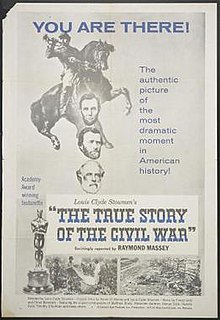
Friendly Persuasion is a 1956 American Civil War drama film produced and directed by William Wyler. It stars Gary Cooper, Dorothy McGuire, Anthony Perkins, Richard Eyer, Robert Middleton, Phyllis Love, Mark Richman, Walter Catlett and Marjorie Main. The screenplay by Michael Wilson was adapted from the 1945 novel The Friendly Persuasion by Jessamyn West. The movie tells the story of a Quaker family in southern Indiana during the American Civil War and the way the war tests their pacifist beliefs.
The Naked Eye is a 1956 American documentary film about the history of photography directed by Louis Clyde Stoumen.

Dimitri Zinovievich Tiomkin was a Russian and American film composer and conductor. Classically trained in Saint Petersburg before the Bolshevik Revolution, he moved to Berlin and then New York City after the Russian Revolution. In 1929, after the stock market crash, he moved to Hollywood, where he became best known for his scores for Western films, including Duel in the Sun, Red River, High Noon, The Big Sky, Gunfight at the O.K. Corral, Rio Bravo, and Last Train from Gun Hill.

Louis Marie Malle was a French film director, screenwriter, and producer who worked in both French cinema and Hollywood. Described as "eclectic" and "a filmmaker difficult to pin down", Malle made documentaries, romances, period dramas, and thrillers. He often depicted provocative or controversial subject matter.

Dorothy Malone was an American actress. Her film career began in 1943, and in her early years, she played small roles, mainly in B-movies, with the exception of a supporting role in The Big Sleep (1946). After a decade, she changed her image, particularly after her role in Written on the Wind (1956), for which she won the Academy Award for Best Supporting Actress.

Donald Patrick Murray was an American actor best known for his breakout performance in the film Bus Stop, which earned him a nomination for Academy Award for Best Supporting Actor. His other films include A Hatful of Rain (1957), Shake Hands with the Devil, One Foot in Hell, The Hoodlum Priest (1961), Advise & Consent, Baby the Rain Must Fall, Conquest of the Planet of the Apes (1972), Deadly Hero (1975), and Peggy Sue Got Married.

Mario Alberto Ettore Monicelli was an Italian film director and screenwriter, one of the masters of the commedia all'italiana. He was nominated six times for an Oscar, and received the Golden Lion for his career.
Joseph M. Newman was an American film director most famous for his 1955 film This Island Earth. His credits include episodes of The Twilight Zone and The Alfred Hitchcock Hour.

Gilberto PontecorvoCavaliere di Gran Croce OMRI was an Italian filmmaker associated with the political cinema movement of the 1960s and 1970s. He is best known for directing the landmark war docudrama The Battle of Algiers (1966). It won the Golden Lion at the 27th Venice Film Festival, and earned him Oscar nominations for Best Director and Best Original Screenplay.

Albert Lamorisse was a French filmmaker, film producer, and writer of short films which he began making in the late 1940s. He also invented the strategic board game Risk in 1957.

Burnett Guffey, A.S.C. was an American cinematographer.
The Ken Burns effect is a type of panning and zooming effect used in film and video production from non-consecutive still images. The name derives from extensive use of the technique by American documentarian Ken Burns. This technique had also been used to produce animatics, simple animated mockups used to previsualize motion pictures, but Burns's name has become associated with the effect in much the same way as Alfred Hitchcock is associated with the dolly zoom.

Hugo Wilhelm Friedhofer was an American composer and cellist best known for his motion picture scores.
The 29th Academy Awards were held on March 27, 1957, to honor the films of 1956.
Louis Clyde Stoumen, known as Lou Stoumen, was an American photographer, film director and producer. He won two Academy Awards; the first in 1957 for Best Documentary Short Subject, and the second in 1963 for Best Documentary Feature.
The Battle of Gettysburg is a 1955 American documentary film about the Battle of Gettysburg during the American Civil War. The film was nominated for two Academy Awards.
Robert D. Webb was an American film director. He directed 16 films between 1945 and 1968. He won the Academy Award for Best Assistant Director for In Old Chicago, the last time that category was offered.
Gordon E. Sawyer was sound director at Samuel Goldwyn Productions. He won 3 Oscars for Best Sound and was nominated a further 13 times.
The Laurel Awards were American cinema awards that honored films, actors, actresses, producers, directors, and composers. This award was created by the Motion Picture Exhibitor magazine, and ran from 1948 to 1971.
A still image film, also called a picture movie, is a film that consists primarily or entirely of still images rather than consecutive still images in succession, forgoing the illusion of motion either for aesthetic or practical reasons. These films usually include a standard soundtrack, similar to what is found in typical sound films, complete with music, sound effects, dialogue or narration. They may also use various editing techniques found in traditional films, such as dissolves, zooms, and panning.










